


xxxxxThe artist Antonio Canaletto gained fame and, for a time, fortune by producing his highly detailed and colourful views of his birthplace Venice. Noted for their brilliant perspective, figure painting and soft, warm glow, they proved particularly popular with English aristocrats on the Grand Tour who were looking for mementoes of their visit. Two works demonstrating his skill are The Doge Visiting San Roco, painted around 1735, and The Upper Reaches of the Grand Canal of 1738, both in the National Gallery in London. To meet and stimulate demand in England, Canaletto was assisted by a number of local patrons. Chief amongst these was Joseph Smith, a wealthy merchant, who drummed up commissions and helped to despatch dozens of works to London. When the War of the Austrian Succession severely reduced the number of aristocrats on the Grand Tour, Canaletto went to live in England in 1746 and stayed for ten years. Here he produced a large number landscapes, his best work being scenes of London and the River Thames. On his return, demand for his view paintings seriously declined, and the man who had immortalised the beauty of Venice died in relative poverty and obscurity. The suffused lighting he created influenced 19th century landscape painting, and among British artists who studied his paintings or drawings were William Hogarth, Richard Wilson, Thomas Girtin and J.M.W. Turner.
ANTONIO CANALETTO 1697 -
(W3, AN, G1, G2, G3a)
Acknowledgements
Canaletto:
portrait by the Italian painter Giambattista Piazzetta (1682-
G2-
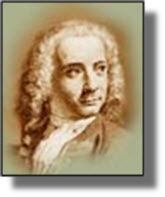 xxxxxThe Italian artist Antonio Canaletto (born
Canal) is well known for his highly detailed and sparkling views of
his native city Venice. The almost photographic-
xxxxxThe Italian artist Antonio Canaletto (born
Canal) is well known for his highly detailed and sparkling views of
his native city Venice. The almost photographic-
xxxxxCanaletto was born in Venice, and his home was not far from the Rialto Bridge. In his early years, he worked for his father, a scene painter and designer, and this would doubtless account for his extraordinary mastery of perspective. They worked together on scenery for Vivaldi's operas, and also travelled to Rome in 1719 to design sets for operas by Alessandro Scarlatti. While there he made some sketches of the ancient ruins and, on his return to Venice, began painting scenes of the city, influenced early on by the "view painter" of the day, Luca Carlevaris. Within a short time he had gained a reputation for the quality of his work, and was catering for a growing number of clients, the majority of them English.
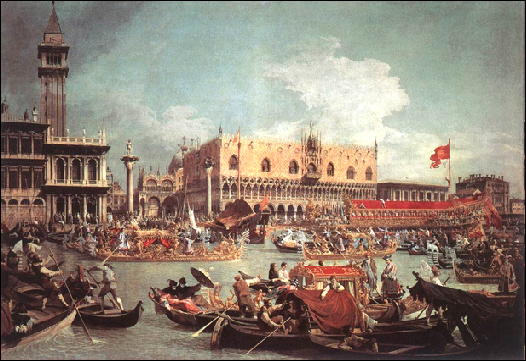
xxxxxHis early work, such as View of Venice (sometimes known as the Stonemason's Yard) depicted daily life in the
back streets, but to meet commercial demand, he was soon
concentrating on the popular tourist attractions, like the Grand
Canal and St. Mark's Square. Although his eye for precise, jewel-
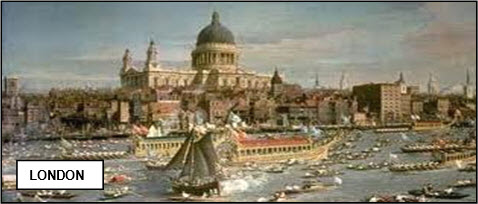 xxxxxIn 1746 Canaletto went to England in search
of customers, the War of the Austrian
Succession having drastically reduced the number of British visitors
to Venice. He stayed, off and on, for ten years, mostly in and around
London. During this time he produced a number of English landscapes,
but it is in his views of London and the River Thames that his work is
seen at its best. Illustrated here is a view of St. Paul’s Cathedral.
His long stay in England made him a popular artist in Britain, at
least in his early years, and there
are a number of his major works in the National Gallery, London. In
addition, before the war virtually put a stop to travelling on the
continent, English aristocrats on the Grand Tour were anxious to buy
scenes of Venice as mementoes of their visit, particularly those
depicting the Grand Canal, St Mark's Square or some colourful local
festival.
xxxxxIn 1746 Canaletto went to England in search
of customers, the War of the Austrian
Succession having drastically reduced the number of British visitors
to Venice. He stayed, off and on, for ten years, mostly in and around
London. During this time he produced a number of English landscapes,
but it is in his views of London and the River Thames that his work is
seen at its best. Illustrated here is a view of St. Paul’s Cathedral.
His long stay in England made him a popular artist in Britain, at
least in his early years, and there
are a number of his major works in the National Gallery, London. In
addition, before the war virtually put a stop to travelling on the
continent, English aristocrats on the Grand Tour were anxious to buy
scenes of Venice as mementoes of their visit, particularly those
depicting the Grand Canal, St Mark's Square or some colourful local
festival.
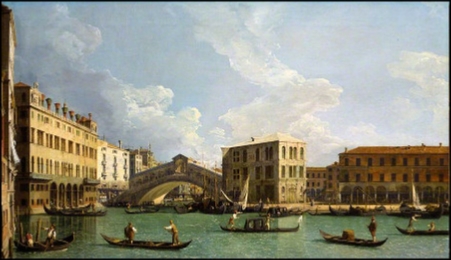 xxxxxHowever, most of his work came through
local patrons. In this respect, the British consul in Venice, the
merchant Joseph Smith (c1682-
xxxxxHowever, most of his work came through
local patrons. In this respect, the British consul in Venice, the
merchant Joseph Smith (c1682-
xxxxxNot very long after leaving England and returning to Venice, Canaletto found work hard to come by, despite recourse to advertising. The popularity of his work began to decline, mainly because there was much repetition of subject matter, and because his paintings tended to lack the sensitivity and the freedom of brushwork shown in his earlier works. In the end, the man who had immortalised the beauty of Venice on canvass died in virtual poverty and obscurity. Nonetheless, his reputation was secured, and the suffused lighting and atmosphere he achieved in his major works had an important influence upon landscape painting in the 19th century. Among British artists who gained from a study of his paintings or drawings were William Hogarth, Richard Wilson, Thomas Girtin and J.M.W. Turner.
xxxxxThe 18th century English phenomenon the Grand Tour was intended to give the young aristocrat an opportunity of travelling for two years or more on the continent, learning a language or two and studying culture in all its forms, be it Renaissance art in Florence, classical antiquity in Rome, or the decorative beauty of Venice. For many it was time well spent, but for as large a number if not more it was a period of enlightenment in the pleasure cities of Europe, none being short of gambling halls, drinking houses and brothels. And Grand Tourists of whatever inclination were often if not generally fleeced, being overcharged for accommodation and carriages, and palmed off with fake antiques or mediocre paintings. Nonetheless it is estimated that by 1769 some 40,000 Englishmen were "running up and down Italy". The Grand Tour was also used by artists and art collectors to show off their wares, but it came to an end with the coming of the Napoleonic Wars, and it never returned in like form.
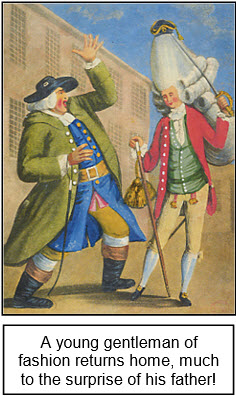 xxxxxFor the most part, the Grand
Tour was an 18th century English phenomenon. It provided, as
it were, a "finishing school" for the young aristocrat, some as young
as sixteen. Together with their tutor, they would journey about the
continent for a couple of years -
xxxxxFor the most part, the Grand
Tour was an 18th century English phenomenon. It provided, as
it were, a "finishing school" for the young aristocrat, some as young
as sixteen. Together with their tutor, they would journey about the
continent for a couple of years -
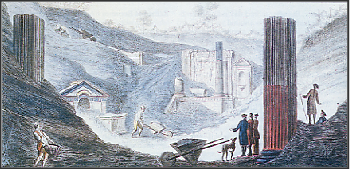 xxxxxFor those who were genuinely interested in
seeing works of classical antiquity and Renaissance art -
xxxxxFor those who were genuinely interested in
seeing works of classical antiquity and Renaissance art -
xxxxxAnd the Grand Tour was
also used by the artist and art connoisseur to meet his continental
counterpart. Such meetings provided a valuable cross-
Including:
Francesco Guardi
and The "Grand Tour"

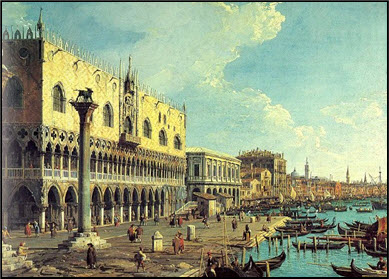
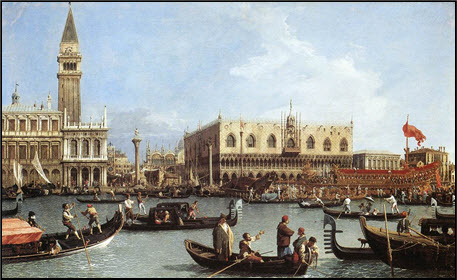
xxxxxIncidentally,
it would seem that Canaletto had few if any pupils working for him.
However, it is likely that his young nephew Bernado
Bellotto (1720-
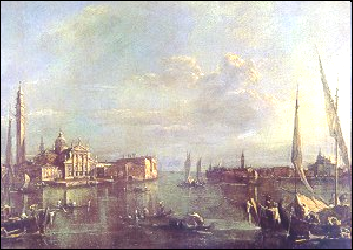 xxxxxThe artist who followed most closely in
Canaletto's footsteps -
xxxxxThe artist who followed most closely in
Canaletto's footsteps -

xxxxxFor his
view paintings, as one would expect, Guardi took as his guide
Canaletto's earlier works, noted for their loose brushwork.
Commercially speaking, they were in no way as successful as
Canaletto's scenes, but they were artistic interpretations rather
than precise, detailed copies, where romanticism took the place of
realism. A good example of his work is the Piazza
San Marco Decorated for the Feast of
the Ascension (1775). Furthermore, as well as painting
the "postcard" pictures of Venice, he took to depicting ruins in
order to evoke imaginative capriccios
(flights of fancy), his freer, lighter handling serving well to
heighten the feeling of enchantment (illustrated above). In some
cases, his shimmering light, together with his casual
brushstrokes, bright spots of colour and broken lines, anticipated
19th century impressionism. It might be said that, whilst
Canaletto faithfully recorded the architecture of Venice -


